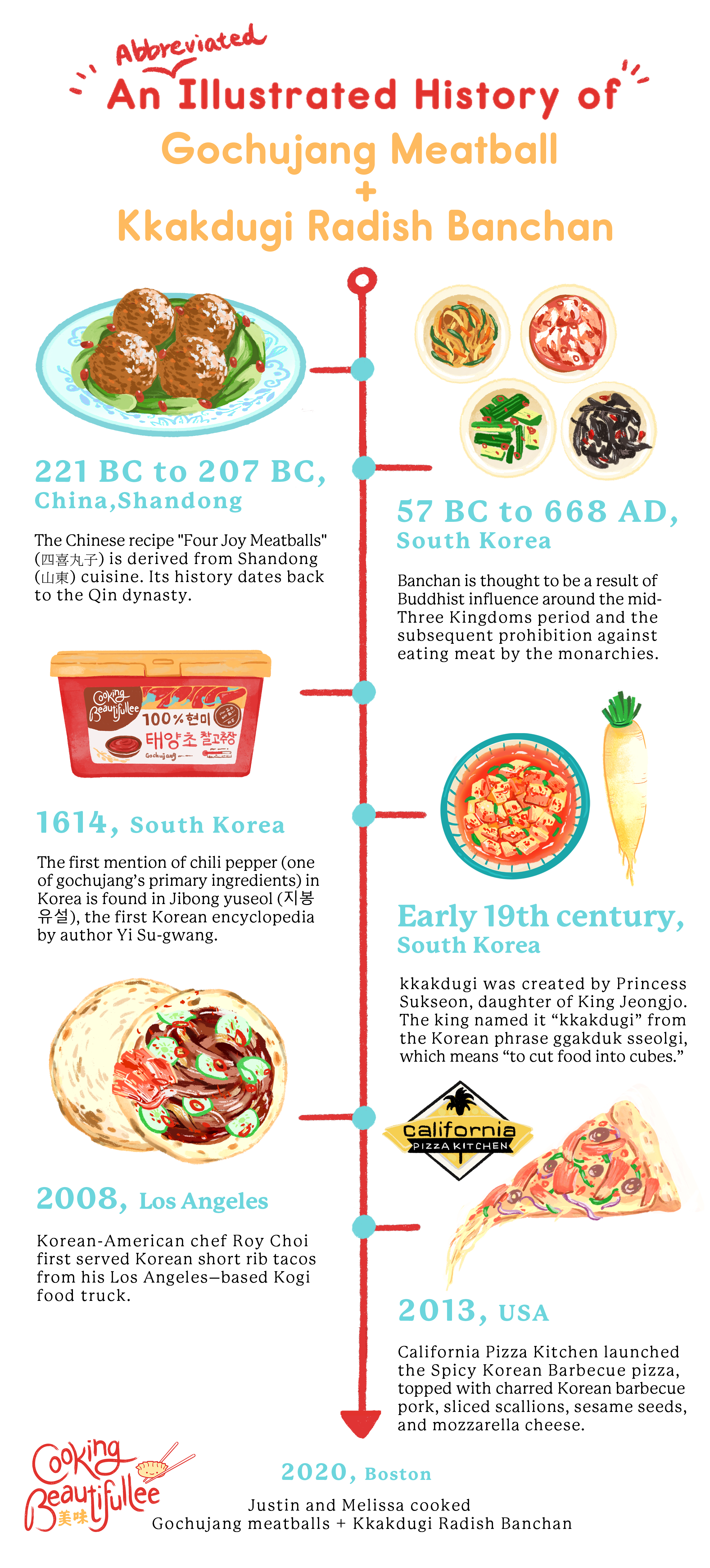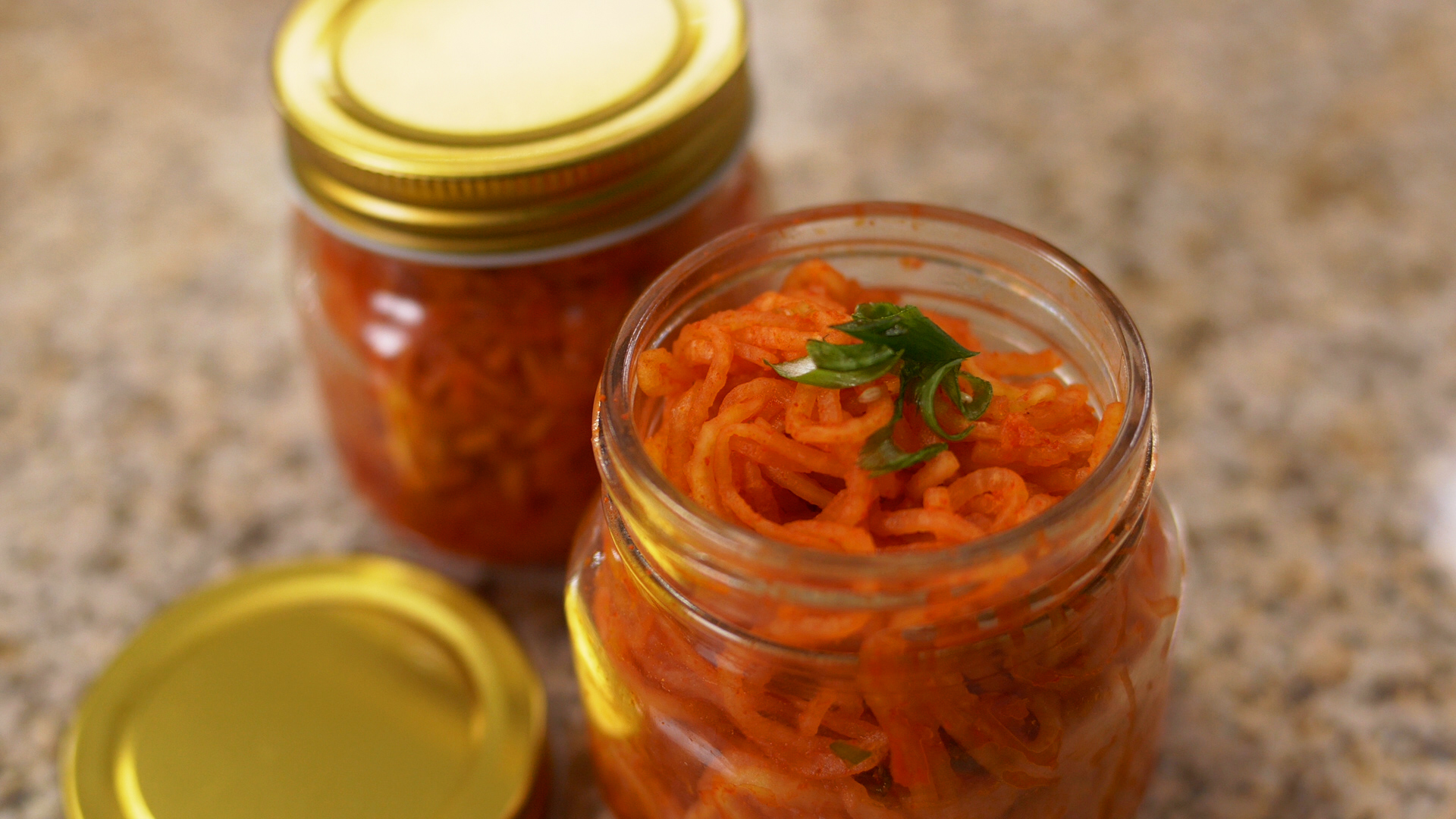Kkakdugi Korean Radish Banchan
In Korean cuisine, banchan is the name for a small side dish served along with cooked rice. We adapted techniques for this kkakdugi radish banchan recipe from one of Maangchi’s videos. She’s a YouTube star who famously cooks Korean dishes. Instead of cutting the Korean radish into cubes, I decided to make radish noodles, since I love zucchini noodles during summertime.
The kkakdugi radish banchan is great for rice or noodles. If you’re looking for a Korean noodle recipe, don’t miss our ram-don noodle recipe—a dish inspired by the award-winning Korean movie Parasite.

Kkakdugi Korean Radish Banchan
Equipment
- Cutting board
- Chef’s knife
- Measuring cups and spoons
- One big bowls
- Hand tools/Gadgets
- Microplane grater
- Spiralizer
- 4 Big jars
Ingredients
- Kkakdugi Radish Banchan Adapted from Maangchi
- 4 lb Korean radish or daikon
- 2 teaspoons salt
- 2 tablespoons sugar
- ¼ cup fish sauce
- ¼ cup gochugaru aka hot pepper flakes
- 4 stalks scallions
- 5 ~6 cloves minced garlic
- 1 1 ” ginger minced
Instructions
- Peel 4 lbs of Korean radishes. Make radish noodles using a spiralizer.
- Add 2 tablespoons of salt and 2 tablespoons of sugar and combine well. If you prefer your kkakdugi sweeter, add 1 more tablespoon of sugar.
- Set aside for 30 minutes.
- Drain the juice from the radish into a small bowl. Reserve ⅓ cup of the juice.
- Add minced garlic, minced ginger, chopped green onions, fish sauce, hot pepper flakes, and ⅓ cup of the juice from the radish.
- Combine well until the seasonings coat the radish noodle evenly.
- Enjoy the kkakdugi right away, or place the kkakdugi in a glass jar and press down on the top of it to remove any air from between the radish noodles.
Notes
Storage Tips
You can store the leftover kkakdugi in the refrigerator. Or you can leave it to ferment at room temperature for a few days. When it starts fermenting, little bubbles may appear on top of the kkakdugi, and it’ll smell strong & sour. When it does, put it in the refrigerator.Chef’s Tips
If you have difficulty finding a Korean radish, a Japanese daikon will work as well. The amount of hot pepper flakes you use depends on your taste; use ¼ cup hot pepper flakes for a mild version. If you can handle the heat and want some kick, ⅓ cup hot pepper will do the trick. For a vegetarian version, replace fish sauce with soy sauce.
Support our YouTube Channel!
We will do our part to leverage this platform to inspire responsible actions. Now more than ever, we’re looking carefully at the best ways to support local businesses and chef-driven independent restaurants.
Donate at Patreon
Here are the Amazon affiliate links for you to order the ingredients and tools to create this delicious dish.
Cutlery
Epicurean Gourmet Series Cutting Board, 17.5-Inch by 13-Inch, Natural/Slate
Miyabi 34313-213 Fusion Morimoto Edition Chef’s Knife, 8-inch, Black w/Red Accent/Stainless Steel
Hand Tools/Gadgets
Kyocera Advanced Ceramic 3-1/2-inch Ceramic Grater
OXO Good Grips 3-Blade Tabletop Spiralizer with StrongHold Suction
Ball Regular Mouth Mason Jars with Lids and Bands, 16-Ounces (4-Pack)
Food
Domino Pure Cane Organic Sugar – 24 oz
Tae-kyung Korean Red Chili Pepper Flakes Powder Gochugaru, 1 Lb
Three Crabs Brand Fish Sauce, 24-Ounce Bottle



Like!! Really appreciate you sharing this blog post.Really thank you! Keep writing.
thanks 🙂